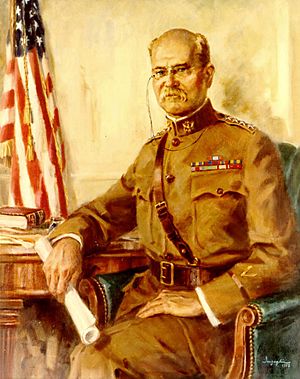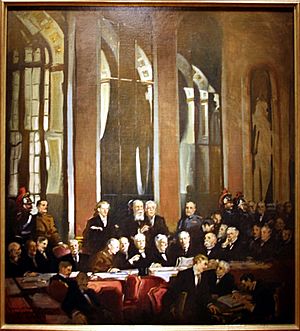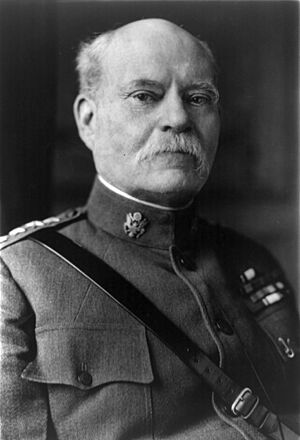Tasker H. Bliss facts for kids
Quick facts for kids
Tasker H. Bliss
|
|
|---|---|

General Tasker H. Bliss by Nicodemus David Hufford (1974)
|
|
| Born | December 31, 1853 Lewisburg, Pennsylvania |
| Died | November 9, 1930 (aged 76) Washington, D.C. |
| Buried | |
| Allegiance | United States |
| Service/ |
United States Army |
| Years of service | 1875–1920 |
| Rank | General |
| Commands held | Chief of Staff of the United States Army |
| Battles/wars | Spanish–American War Moro Rebellion World War I |
| Awards | Army Distinguished Service Medal |
Tasker Howard Bliss (December 31, 1853 – November 9, 1930) was an important officer in the United States Army. He served as the top military leader, known as the Chief of Staff of the United States Army, from 1917 to 1918. He was also a diplomat who helped with the peace talks after World War I. He even signed the Treaty of Versailles for the United States.
Contents
Early Life and Education
Tasker Howard Bliss was born in Lewisburg, Pennsylvania. He went to Bucknell University for a year. Later, he joined the United States Military Academy (USMA) at West Point, New York. At West Point, he was very good at languages, math, and military tactics. He graduated as one of the top students in his class in 1875.
Military Career Begins
After graduating, Bliss became a second lieutenant in the 1st Artillery. He worked at army bases in Georgia and New York. In 1876, he became a French teacher at West Point. He taught there until 1882 and was promoted to first lieutenant.
In 1882, Bliss married Eleanor E. Anderson. He was then sent to army posts in California and Virginia. Their daughter, Eleanora, was born in 1884. In 1885, he taught at the Naval War College. He traveled to England, Germany, and France to study their military schools. He wanted to see if U.S. military schools were teaching the right things.
He returned to the U.S. in 1888. He became a special assistant, called an aide-de-camp, to the U.S. Army's top general, John M. Schofield. During this time, his son Edward Goring was born in 1892. In 1892, he was promoted to Captain. He later worked for the Secretary of War. In 1897, he was sent to Spain as a military attaché. This meant he was a military expert working at the U.S. embassy. When war broke out between Spain and the U.S., he was called back home.
Spanish–American War Service
In 1898, Bliss was promoted to major and then to lieutenant colonel. He worked as a chief supply officer for the army. He was assigned to the 6th Army Corps. He then went to Cuba and later to Puerto Rico. In Puerto Rico, he became the Chief of Staff for the 1st Division. He also helped choose camp sites in Cuba.
Time in Cuba and Beyond
In December 1898, Bliss was sent to Havana, Cuba. He became the Collector of Customs for the island and the Port of Havana. This meant he was in charge of collecting taxes on goods coming into Cuba. He also led a group to update the Cuban Tariff Treaty in 1901. This treaty was an agreement about trade between the U.S. and Cuba. It was signed in 1903.
Leading the Army
In 1903, Tasker Bliss became a brigadier general. He was appointed by President Theodore Roosevelt. He became a member of the General Staff and president of the United States Army War College. This is a school for high-ranking army officers.
In 1905, General Bliss was sent to the Philippine Islands. He commanded army departments there. In 1906, he became the governor of the Moro Province in the Philippines. He commanded the Philippine Division in 1908. After touring China, he returned to the U.S. in 1909. He continued to serve on the general staff and as president of the Army War College. He later commanded army departments in California, New York, and Texas.
World War I and Peace Talks

In 1915, Bliss became the Assistant Chief of Staff for the Army. He was promoted to major general in 1915. In 1917, he became the Chief of Staff of the U.S. Army, the highest-ranking officer. He was also made a full general (four stars).
In November 1917, he became the American military representative to the Supreme War Council. This was a group of top military leaders from the Allied countries during World War I. Even though he was supposed to retire in December 1917 due to age, President Woodrow Wilson asked him to stay on active duty. He was sent to Versailles, France, to continue his work on the Supreme War Council.
He stopped being the U.S. Army Chief of Staff in May 1918. After World War I ended in November 1918, Bliss had two important roles. He remained the American military representative on the Supreme War Council. He was also a Plenipotentiary at the Paris Peace Conference. This meant he had full power to represent the U.S. and negotiate the peace treaty. His work there finished in December 1919.
Later Life and Legacy
In 1920, Bliss became the governor of the U.S. Soldiers Home in Washington, D.C. He retired from this job in 1927. He was reinstated as a full general and retired again in 1930.
Tasker Howard Bliss passed away on November 9, 1930. He is buried at Arlington National Cemetery in Washington, D.C.
Family Life
Tasker and Eleanor Bliss had a son named Edward Goring Bliss. Edward was born in 1892 and also graduated from West Point. He served in the military through World War II and retired as a lieutenant colonel.
Their daughter, Eleanora, was born in 1885. She went to Bryn Mawr College and became the first woman to earn a doctorate in geology. She worked for the United States Geological Survey. There, she met and married another geologist, Adolph Knopf.
Honors and Namesakes
Two U.S. Navy ships were named after General Tasker H. Bliss: USS Tasker H. Bliss (AP-42) and USS General T. H. Bliss (AP-131).
A painting of General Bliss hangs in Luce Hall at the United States Naval War College.
It's a common mistake, but Fort Bliss, Texas is not named after him. It was named after Lieutenant Colonel William Wallace Smith Bliss, who was a hero in the Mexican–American War.
Awards and Decorations
| Army Distinguished Service Medal | |
| Spanish Campaign Medal | |
| Philippine Campaign Medal | |
| Army of Cuban Occupation Medal | |
| Mexican Border Service Medal | |
| World War I Victory Medal | |
| Knight Grand Cross of the Order of St Michael and St George (UK) | |
| Grand Croix Légion d'Honneur (France) | |
| Grand Cross Order of the Crown (Belgium) | |
| Grand Cross Order of Saints Maurice and Lazarus (Italy) | |
| Grand Cordon Order of the Rising Sun (Japan) | |
| Polonia Restituta (Poland) | |
| War Merit Cross (Italy) | |
| Medal of Solidarity, 1918 (Panama) |
Other Honors
- Graduated with honors from Artillery School in 1884.
- Received honorary Doctor of Laws degrees from Bucknell University (1916), Western Reserve University (1923), and Harvard University (1927).
- Received an honorary Doctor of Military Science degree from Pennsylvania Military College (1925).


